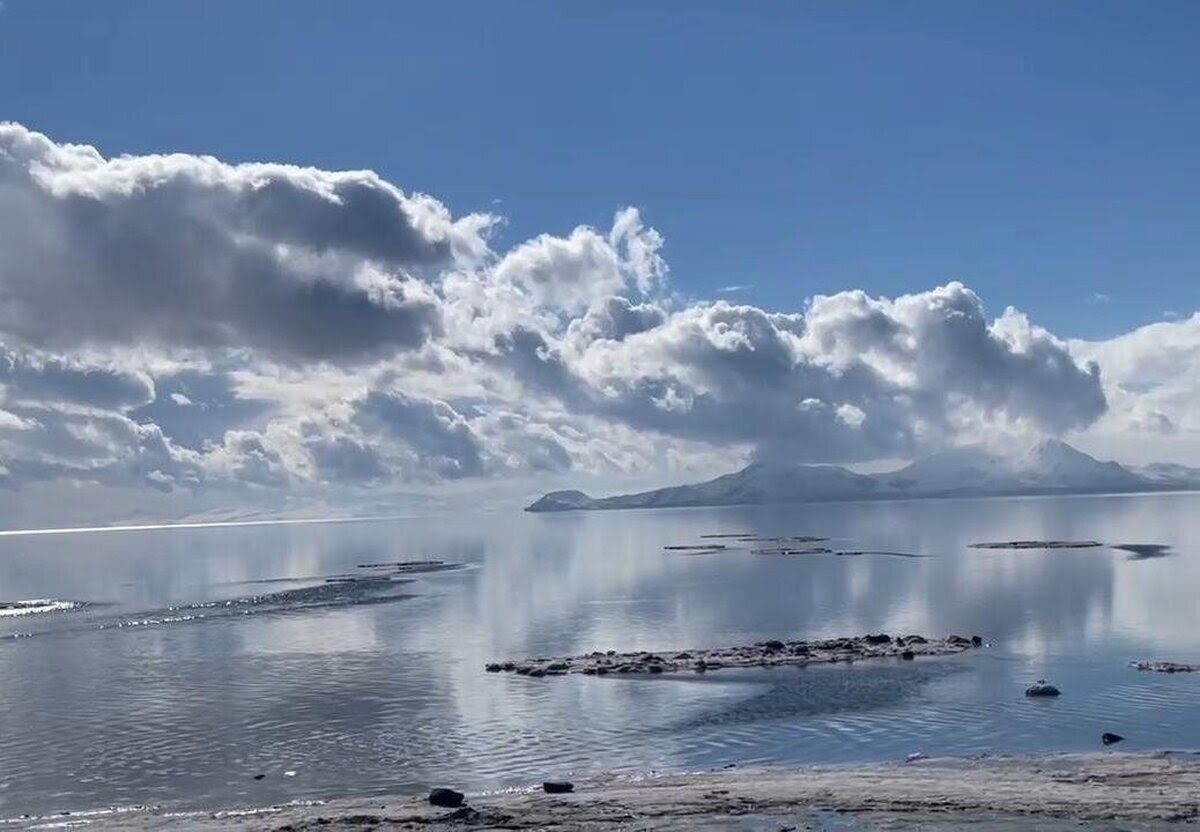Lake Urmia’s area expands year on year

TEHRAN –Satellite images show that the area of Lake Urmia measured on February 22 was equal to 2,061 square kilometers which has increased compared to 1,819 square kilometers on March 7, 2023.
Lake Urmia in the northwestern West Azarbaijan province started to dry up in the 2000s. The lake is the largest in West Asia and the sixth-largest salt lake in the world with a water surface area of 5,000 to 6,000 square kilometers.
Following the recent precipitations across the country and the importance of reviving wetlands and lakes, the country's mapping organization monitored Lake Urmia’s area using satellite images from the Iranian calendar year 1401 (March 2022- March 2023) to 1402 (March 2023-March 2024), ISNA reported.
The southern part of the lake has expanded notably.
Japan-funded FAO project
The Food and Agriculture Organization of the United Nations (FAO), with the support of the government of Japan, identified technical agricultural solutions to increase water efficiency in the agriculture sector at the Lake Urmia basin, which may be efficient in saving the internationally known biosphere reserves.
Since 1995, Lake Urmia has been shrinking due to rapid upstream agricultural expansion and climate change. These forces have pushed the precious lake to the verge of depletion and have put the region’s health, economy, environment, industry, and agriculture at risk.
Despite the efforts of the Lake Urmia Restoration Program National Committee and its focus on the Lake’s restoration since 2013, the continuation of the critical situation demonstrates that sustainability, macro and micro, management solutions should be considered as the main essence of action plans.
In a concerted effort to address the challenges facing the Lake Urmia Basin in 2016, FAO launched the "Integrated Program for Sustainable Water Resources Management in the Lake Urmia Basin,” which was funded by the Government of Japan.
Key technical outcomes of this initiative included the implementation of a water accounting plus project in the Lake Urmia Basin and the identification of water-consuming hotspots within the basin. Notably, water accounting revealed the significant contribution of irrigated and rainfed agriculture to the Lake's total evapotranspiration, emphasizing the importance of water-saving measures for the Lake's restoration.
Another subsequent development was the establishment of a drought monitoring system by introducing and putting in place new indexes, predicting an intensified water shortage as a foreseeable future for Lake Urmia, exacerbated by rising temperatures.
Acknowledging the challenge of reducing evapotranspiration as the critical point of losing water without compromising farmers' livelihoods, the project's third phase focused on socio-economic and livelihood planning.
The fourth component of the project focused on seeing the big picture and promoting basin management and involved a comprehensive study of a sub-basin as a model for other sub-basins, resulting in the creation of a framework of Integrated Watershed Management plans aimed at reducing water consumption in the agriculture sector.
The final phase centered on developing capacity among stakeholders and partners, ensuring the effective utilization of developed tools such as water accounting plus, real water savings monitoring, and drought monitoring tools.
Water transport project
The lake’s restoration program was established in 2013 and aims to restore the lake within a 10-year program.
The Kanisib tunnel is the most important structure for transferring water to Lake Urmia to prevent it from drying out.
On February 24, 2023, the first phase of a national project to transfer water from the Kanisib Dam to Lake Urmia came on stream.
The construction of a tunnel with a length of 36 kilometers to transfer water from the Kanisib Dam to Lake Urmia started in 2015, IRNA reported.
Some 35 trillion rials (about $77 million) have been spent on the project.
In the first phase, 300 million cubic meters of water were projected to enter Lake Urmia every year.
The wastewater treatment plant of the city of Urmia, as the second project aimed at reviving Lake Urmia, will come on stream in the near future.
Once the project is inaugurated, 51 million cubic meters of treated wastewater will be transferred to Lake Urmia, Motamedian said, IRIB reported.
This important project started in the calendar year 1394 (March 2015-March 2016) but stopped in the year 1399 (March 2020-March 2021) due to financial problems, he explained.
Some 5 trillion rials (about $10 million) have been recently earmarked for speeding up the implementation of the Lake Urmia revival plan.
Finland ready to help
In November 2023, Finland's ambassador to Iran, Kari Kahiluoto, announced his country’s readiness to cooperate in the restoration of Lake Urmia.
Finland is willing to expand its long-term cooperation with Iran in the fields of water, energy, and waste management, he said.
Water transfer from Lake Van
Research and academic studies are being carried out on transferring water from Lake Van in Turkey to help revive Lake Urmia which has been drying up in recent years, MP Mohammad–Reza Mirtajeddini said in September 2023.
"Four universities have conducted scientific studies and research to transfer water from Lake Van to Lake Urmia which are 160 kilometers away from each other,” Mirtajeddini pointed out.
Moreover, "Within the past two months, several meetings have been held in the parliament discussing the situation of Lake Urmia. The first vice president, the head, and the secretary of the Lake Urmia restoration headquarters were following up on the work. Most of the hardware projects have been done out of all the plans and proposals.”
Lake Urmia restoration headquarters needs 23,000 billion rials (about $46,000) this year, part of which has been paid out and the rest will be allocated, the MP added.
To implement the restoration projects, water is needed. Due to the low rainfall in the past, water was not released from the Kanisib dam.
MT/MG
Leave a Comment